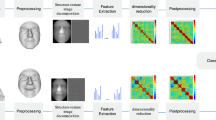Abstract
Illumination variation is an essential trait in texture analysis, since the same texture can be surrounded with different illuminations, which can greatly affect the classification rate. This paper introduces a new approach to extract the texture features applying illumination normalization-based texture descriptors. The prime objective is to enhance the classification accuracy by normalizing the illumination of colour textures. Normalization of illumination is achieved by applying homomorphic filter. For feature extraction, two relevant approaches grey-level co-occurrence matrix (GLCM) and Laws’ mask are utilized. Experiments are conducted for normalized co-occurrence and Laws’ filter for colour images. Classification rates of the traditional GLCM and Laws’ mask descriptors are included for baseline comparison. The effectiveness of the introduced techniques is assessed on three benchmark texture datasets, i.e. STex, VisTex, and ALOT. A k-nearest neighbour (k-NN) classifier is utilized to perform texture classification. Results show that the proposed approach has achieved higher classification rates and outperformed existing methods.
Similar content being viewed by others
References
Tan, T.S.C.; Kittler, J.: Colour texture analysis using colour histogram. IEEE Proc. Vis. Image Signal Proces 141(6), 403–412 (1994)
Kyllonen, J.; Pietikainen, M.: 5-1 Visual inspection of parquet slabs by combining color and texture. In: Proceedings of IAPR Workshop on Machine Vision Applications (MVA’00). November 28–30, Tokyo, Japan. pp. 187–192 (2000). http://citeseerx.ist.psu.edu/viewdoc/summary?doi=10.1.1.145.4457
Drimbarean, A.; Whelan, P.F.: Experiments in colour texture analysis. Patt. Recogn. Lett. 22, 1161–1167 (2001). https://doi.org/10.1016/S0167-8655(01)00058-7
Palm, C.; Lehmann, T.M.: Classification of colour textures by Gabor filtering. Mach. GRAP. Vis. 11(2/3), 195–219 (2002). https://doi.org/10.1109/34.41384
Palm, C.: Colour texture classification by integrative co-occurrence matrices. Patt. Recogn. 37, 965–976 (2004). https://doi.org/10.1016/j.patcog.2003.09.010
Arivazhagan, S.; Ganesan, L.; Angayarkanni, V.: Color texture classification using WSFs and WCFs. Multi. Cyperscape J.-Special Iss. Mult. Data Proc. Comp. 3(4), 297–302 (2005). https://doi.org/10.1109/ICCIMA.2005.46
Arivazhagan, S.; Ganesan, L.; Joyson, C.T.: Color texture image classification using wavelet texture spectral features. Int. J. Biomed. Eng. Consum. Health Inform. 3(1), 21–27 (2011). ISSN: 0973-6727.
Dey, M.; Raman, B.; Verma, M.: A novel colour-and texture-based image retrieval technique using multi-resolution local extrema peak valley pattern and RGB colour histogram. Pattern Anal. Appl. 19(4), 1159–1179 (2016)
Haralick, R. M.: Statistical and structural approaches to texture. In: Proceedings of IEEE (Vol. 67, pp. 786–804). (1979). https://doi.org/10.1109/proc.1979.11328
Laws, K.I.: Texture energy measures. In: Image Und. Workshop. (1979).
Ojala, T.; Pietikainen, M.; Maenpaa, T.: Multi resolution gray-scale and rotation invariant texture classification with local binary patterns. IEEE Trans. Pattern Anal. Mach. Intell. 24, 971–987 (2002). https://doi.org/10.1109/TPAMI.2002.1017623
Unser, M.: Texture classification and segmentation using wavelet frames. IEEE Trans. Image. Process. 4(11), 1549–1560 (1995). https://doi.org/10.1109/83.469936
Manjunath, B.S.; Ma, W.Y.: Texture features for browsing and retrieval of large image data. IEEE Trans. Patt. Anal. Machine Intell. 18(8), 837–849 (1996). https://doi.org/10.1109/34.531803
Arivazhagan, S.; Ganesan, L.: Texture classification using wavelet transform. Patt. Recogn. Lett. 24(9–10), 1513–1521 (2003). https://doi.org/10.1016/S0167-8655(02)00390-2
de Siqueira, F.R.; Schwartz, W.R.; Pedrini, H.: Multi-scale gray level co-occurrence matrices for texture description. Neurocomputing 120, 336–345 (2013). https://doi.org/10.1016/j.neucom.2012.09.042
Yadav, A.R.; Anand, R.S.; Dewal, M.L.; Gupta, S.: Multiresolution local binary pattern variants based texture feature extraction technique for efficient classification of microscopic images of hard wood species. App. Soft Comp. 32, 101–112 (2015). https://doi.org/10.1016/j.asoc.2015.03.039
Yadav, A.R.; Anand, R.S.; Dewal, M.L.; Gupta, S.: Gaussian image pyramid based texture features for classification of microscopic images of hardwood species. Optik. 126(24) 5570–5578 (2015). https://doi.org/10.1016/j.ijleo.2015.09.030.
Dash, S.; Jena, U.R.: Texture classification using steerable pyramid based Laws’ masks. J. Elect. Syst. Inform. Tech. 4, 185–197 (2017). https://doi.org/10.1016/j.jesit.2016.10.001
Du, S.; Ward, R.: Wavelet-based illumination normalization for face recognition. In: IEEE International Conference on Image Processing (ICIP 2005), Vol. 2, (2005). https://doi.org/10.1109/ICIP.2005.1530215
Jobson, D.J.; Rahman, Z.; Woodell, G.A.: A multiscaleretinex for bridging the gap between color images and the human observation of scenes. IEEE Trans. Image. Proc. 6(7), 965–976 (1997). https://doi.org/10.1109/83.597272
Delac, K.; Grgic, M.; Kos, T.: Sub-image homomorphic filtering technique for improving facial identification under difficult illumination conditions. In: International Conference System, Signals and Image Processing pp. 95–98 (2006). http://citeseerx.ist.psu.edu/viewdoc/download?doi=10.1.1.118.1579&rep=rep1&type=pdf
Wang, W.; Song, J.; Yang, Z.; Chi, Z.: Wavelet-based illumination compensation for face recognition using eigenface method. In: Proceedings 6th World Congress Intelligent Control and Automation, Dalian, China (2006). https://doi.org/10.1109/WCICA.2006.1714031
Chen, W.; Joo Er, M.; Wu, S.: Illumination compensation and normalization for robust face recognition using discrete cosine transform in logarithm domain. IEEE Trans. Syst. Man Cybern. 36(2), 458–466 (2006). https://doi.org/10.1109/TSMCB.2005.857353
Xie, X.; Lam K-N.: An efficient illumination normalization method for face recognition. Patt. Recg. Lett. 27, 609–617 (2006). https://doi.org/10.1016/j.paterc.2005.09.026
Emadi, M.; Khalid, M.; Yusof, R.; Navabifar, F.: Illumination normalization using 2D Wavelet. Procedia Eng. 41, 854–859 (2012). https://doi.org/10.1016/j.proeng.2012.07.254
Tan, X.; Triggs, B.: Enhanced local texture feature sets for face recognition under difficult lighting conditions. IEEE Trans. Image Proc. 19(6), 1635–1650 (2010). https://doi.org/10.1109/TIP.2010.2042645
Fan, C.N.; Zhang, F.Y.: Homomorphic filtering based illumination normalization method for face recognition. Patt. Recog. Lett. 32, 1468–1479 (2011). https://doi.org/10.1016/j.patrec.2011.03.023
Maenpaa, T.; Pietikainen, M.: Classification with color and texture: jointly or separately? Patt. Recogn. 37(8), 1629–1640 (2004). https://doi.org/10.1016/j.patcog.2003.11.011
Burghouts, G.J.; Geusebroek, J.M.: Material-specific adaption of colour invariant features. Patt. Recgon. Lett. 30, 306–313 (2009). https://doi.org/10.1016/j.patrec.2008.10.005
Vacha, P.; Haindl, M.: Texture recognition using robust Markovian features. In: International Workshop on Computational Intelligence for Multimedia Understanding. Springer, Berlin, pp. 126–137 (2012). https://doi.org/10.1007/978-3-642-32436-9-11
Kononenko, I.; Kukar, M.: Machine learning and data mining: introduction to principles and algorithms. Horwood Publishing Ltd, Chichester (2007)
Everitt, B.S.; Landau, S.; Leese M.; Stahl, D.: Miscellaneous clustering methods. In Cluster Analysis. Wiley Series in Probability and Statistics. Wiley, New York, pp. 215–255 (2011). https://doi.org/10.1002/9780470977811.ch8
Hastie, T.; Tibshirani R.; Friedman, J.: The elements of statistical learning. Springer series in statistics, New York, Vol. 1, pp. 241–249, (2009). https://doi.org/10.1007/978-0-387-84858
Department of Computer Sciences, U. S., Salzburg texture image database (STex), http://www.wavelab.at/sources/STex/.
VisTex, Texture dataset, http://vismod.media.mit.edu/vismod/imagery/VisionTexture/vistex.html.
Amsterdam library of textures (ALOT), http://www.science.uva.nl/~mark/ALOT.
Author information
Authors and Affiliations
Corresponding author
Rights and permissions
About this article
Cite this article
Dash, S., Jena, U.R. & Senapati, M.R. Homomorphic Normalization-Based Descriptors for Texture Classification. Arab J Sci Eng 43, 4303–4313 (2018). https://doi.org/10.1007/s13369-017-2961-9
Received:
Accepted:
Published:
Issue Date:
DOI: https://doi.org/10.1007/s13369-017-2961-9




